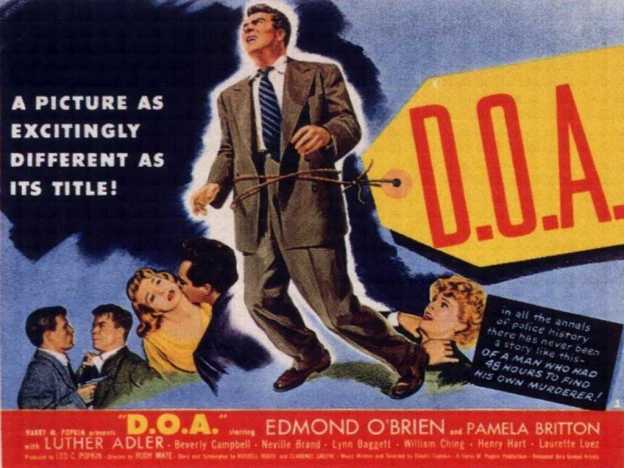
Greetings, readers! This week is the last of my blog posts for Noirvember 2017. I know. It makes me sad too. But for my last noir film I have chosen a real hidden gem. It’s 1949’s D.O.A. It starts with a shocking opening and then only gets more intense and spectacular from there. It has one of the most compelling narrative arcs in all of noir. It may not be mentioned as a great noir film as often as, say, The Maltese Falcon or Double Indemnity. But it’s essential viewing for anyone who loves the genre.
The film stars Edmond O’ Brien as a man who’s been poisoned, told he has only days to live, and how he tries to find out who did to him and why.
Frank Bigelow (Edmond O’ Brien) goes off to San Francisco for a week’s holiday. He’s a self-employed accountant and is engaged to his assistant Paula Gibson (Pamela Britton). He checks into the St. Francis Hotel and is soon partying with a group of salesman who are having a party. He ends up at a jive bar where a mysterious stranger switches drinks with him. He awakens the next morning feeling unwell and after having some medical tests is told that he’s been poisoned and there is no cure. He has one week to live. When Paula tells him that a man in Los Angeles had been trying to reach him, he sets off to learn if there might be any connection to his current situation. Unfortunately, the man committed suicide by jumping off his high-rise apartment balcony not long after trying to contact him. He soon learns that some very shady characters are involved but why they might be interested in him is what he really wants to know.–IMDB
D.O.A. gets a great deal of its tension from the almost real-time narrative. Right from the opening we know the stakes are high. The opening credits feature Bigelow walking down a long corridor to see a policeman. The music (composed by the great Dimitri Tiomkin) playing over the credits has an almost march to the gallows feel. And that’s exactly the right tone for the story. The film wastes no time in telling us the plot and involving us in the situation of the Edmond O’ Brien character. He reports his future murder by poisoning to a policeman, and then tells the story in flashbacks. By the way, if the police captain at the beginning looks familiar, it’s because he’s played by prolific character actor Roy Engel. He played Doc. Martin on the hit series Bonanza, among other things. But I digress.
D.O.A. succeeds for a multitude of reasons. The primary one is that Edmond O’ Brien’s performance is nothing short of brilliant. He’s believable as the dogged every man in an impossible situation. He’s convincingly vulnerable when he finds out his medical diagnosis. And he’s a likable yet complex character who we root for every second of the movie. O’ Brien had a long and storied career that included a few other noir classics: White Heat and The Killers. I still think he doesn’t get enough credit as an actor. His performance in D.O.A. is a tour de force.
I also want to give credit to Pamela Britton who plays O’ Brien’s love interest. Her compassion for him feels genuine and it’s heartbreaking knowing how their story line is going to end. Noir is just not the place for happy endings.
Another thing that’s fascinating about D.O.A. is that it was directed by Rudolph Mate. He has 32 directing credits between the big and small screen. But he was primarily known as a cinematographer. Among his impressive cinematography credits are: Foreign Correspondent, The Pride of the Yankees, and Gilda. Mate proves himself to be a solid noir director with D.O.A. It’s a shame he didn’t work more in the genre. But we have many films that look great thanks to his camera skills. So all is not lost.
D.O.A. plays like a real-time crime drama. It’s thoroughly involving and a great example of film noir. If you haven’t seen it, I urge you to check it out.
That’s a wrap for Noirvember. See you in December!


